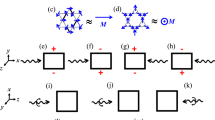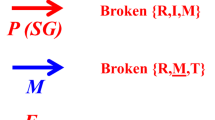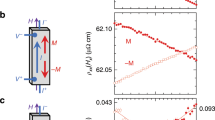Abstract
The desire to maximize the sensitivity of read/write heads (and thus the information density) of magnetic storage devices has stimulated interest in the discovery and design of new magnetic materials exhibiting magnetoresistance. Recent discoveries include the ‘colossal’ magnetoresistance in the manganites1,2,3,4 and the enhanced magnetoresistance in low-carrier-density ferromagnets4,5,6. An important feature of these systems is that the electrons involved in electrical conduction are different from those responsible for the magnetism. The latter are localized and act as scattering sites for the mobile electrons, and it is the field tuning of the scattering strength that ultimately gives rise to the observed magnetoresistance. Here we argue that magnetoresistance can arise by a different mechanism in certain ferromagnets—quantum interference effects rather than simple scattering. The ferromagnets in question are disordered, low-carrier-density magnets where the same electrons are responsible for both the magnetic properties and electrical conduction. The resulting magnetoresistance is positive (that is, the resistance increases in response to an applied magnetic field) and only weakly temperature-dependent below the Curie point.
This is a preview of subscription content, access via your institution
Access options
Subscribe to this journal
Receive 51 print issues and online access
$199.00 per year
only $3.90 per issue
Buy this article
- Purchase on Springer Link
- Instant access to full article PDF
Prices may be subject to local taxes which are calculated during checkout




Similar content being viewed by others
References
Searle,C. W. & Wang,S. T. Studies of the ionic ferromagnet (LaPb)MnO3. III Ferromagnetic resonance studies. Can. J. Phys. 47, 2703–2708 ( 1969).
Jin,S. et al. Thousandfold change change in the resistivity in magnetoresistive La-Ca-Mn-O films. Science 264, 413– 415 (1994).
Tokura,Y. et al. Origins of colossal magnetoresistance in perovskite-type manganese oxides. J. Appl. Phys. 79, 5288– 5291 (1996).
Shimakawa,Y., Kubo,Y. & Manako,T. Giant magnetoresistance in Tl2Mn2O7 with the pyrochlore structure. Nature 379, 53 –55 (1996).
Ramirez,A. P. & Subramanian,M. A. Large enhancement of magnetoresistance in Tl2Mn2O7: pyrochlore versus perovskite. Science 277, 546–549 (1997).
Majumdar,P. & Littlewood,P. B. Dependence of magnetoresistivity on charge-carrier density in metallic ferromagnets and doped magnetic semiconductors. Nature 395, 479–481 (1998).
Aeppli,G. & Fisk,Z. Kondo insulators. Comments Condens. Matter Phys. 16, 155–165 (1992).
Wernick,J. H., Wertheim,G. K. & Sherwood, R. C. Magnetic behavior of the monosilicides of the 3d-transition elements. Mater. Res. Bull. 7, 1431– 1441 (1972).
Jaccarino,V., Wertheim,G. K., Wernick,J. H., Walker,L. R. & Arajs,S. Paramagnetic excited state of FeSi. Phys. Rev. 160, 476–482 (1967).
Schlesinger,Z. et al. Unconventional charge gap formation in FeSi. Phys. Rev. Lett. 71, 1748–1751 (1993).
van der Marel,D., Damascelli,A., Schulte,K. & Menovsky,A. A. Spin, charge, and bonding in transition metal mono-silicides. Physica B 244, 138–147 ( 1998).
DiTusa,J. F. et al. Metal-insulator transitions in the Kondo insulator FeSi and classic semiconductors are similar. Phys. Rev. Lett. 78, 2831(1997); erratum 78, 4309 (1997).
Chernikov,M. A. et al. Low-temperature transport, optical, magnetic, and thermodynamic properties of Fe1-xCoxSi. Phys. Rev. B 56, 1366–1375 (1997).
Moriya,T. Spin Fluctuations in Itinerant Electron Magnetism (ed. Fulde, P.) (Springer, Berlin/Heidelberg/New York/Tokyo, 1985).
Beille,J., Voiron,J. & Roth,M. Long period helimagnetism in the cubic B20 FexCo1- xSi and CoxMn1-xSi alloys. Solid State Commun. 47, 399–402 (1983).
Ishimoto,K., Ohashi,M., Yamauchi,H. & Yamaguchi,Y. Itinerant electron ferromagnetism in Fe0.8Co0.2Si studied by polarized neutron diffraction. J. Phys. Soc. Jpn 61, 2503–2511 (1992).
Kawarazaki,S., Yasuoka,H., Nakamura,Y. & Wernick,J. H. Magnetic properties of (Fe1-xCox)Si. J. Phys. Soc. Jpn 41, 1171 (1976).
Paschen,S., Pushin,D., Ott,H. R., Young,D. P. & Fisk,Z. Magnetism and electrical transport in Fe0.9TM 0.1Si, TM = Co, Rh, Ru. Physica B 259–261 , 864–865 (1999).
Ueda,K. Effect of a magnetic field on spin fluctuations in weakly ferromagnetic metals. Solid State Commun. 19, 965–968 (1976).
Kadowaki,K., Okuda,K. & Date,M. Magnetization and magnetoresistance of MnSi. I. J. Phys. Soc. Jpn 51, 2433–2438 ( 1982).
Hwang,H., Cheong,S.-W., Ong,N. P. & Batlogg,B. Spin-polarized intergrain tunneling in La2/3Sr1/3MnO3. Phys. Rev. Lett. 77, 2041–2044 (1996).
Campbell,I. A. & Fert,A. Ferromagnetic Materials Vol. 3 (ed. Wohlfarth, E. P.) 751– 804 (North-Holland, Amsterdam, 1982).
Xu,R. et al. Large magnetoresistance in non-magnetic silver chalcogenides. Nature 390, 57–60 ( 1997).
Lee,P. A. & Ramakrishnan,T. V. Disordered electronic systems. Rev. Mod. Phys. 57, 287– 337 (1985).
Al’tshuler,B. L., Aronov,A. G., Gershenson, M. E. & Sharvin,Yu. V. Quantum effects in disordered metal films. Sov. Sci. Rev. A Phys. 9, 223–354 ( 1987).
Rosenbaum,T. F. et al. Metal-insulator transition in a doped semiconductor. Phys. Rev. B 27, 7509–7523 (1983).
Millis,A. J. & Lee,P. A. Spin-orbit and paramagnon effects on magnetoconductance and tunneling. Phys. Rev. B 30 , 6170–6173 (1984); erratum 31, 5523–5524 (1985).
Ishikawa,Y., Tajima,K., Bloch,D. & Roth,M. Helical spin structure in manganese silicide MnSi. Solid State Commun. 19, 525–528 (1976).
Acknowledgements
We thank E. Abrahams, P.W. Adams, D.A. Browne, P. Littlewood and A. Ruckenstein for discussions. J.F.D. acknowledges the support of the Louisiana Board of Regents. J.F.D. and Z.F. acknowledge the support of the National Science Foundation.
Author information
Authors and Affiliations
Corresponding author
Rights and permissions
About this article
Cite this article
Manyala, N., Sidis, Y., DiTusa, J. et al. Magnetoresistance from quantum interference effects in ferromagnets. Nature 404, 581–584 (2000). https://doi.org/10.1038/35007030
Received:
Accepted:
Issue Date:
DOI: https://doi.org/10.1038/35007030
This article is cited by
-
Colossal angular magnetoresistance in ferrimagnetic nodal-line semiconductors
Nature (2021)
-
Anomalous low-temperature transport property of oxygen containing high-entropy Ti-Zr-Hf-Cu-Ni metallic glass thin films
Science China Materials (2019)
-
Microstructural, magnetic, electrical transport and large magnetoresistance properties of La0.57Nd0.1Sr0.13 Ag0.2MnO3
Journal of Electroceramics (2019)
-
Anisotropic magnetic coupling with a two-dimensional characteristic in noncentrosymmetric Cr11Ge19
Scientific Reports (2016)
-
Magnetic moments induce strong phonon renormalization in FeSi
Nature Communications (2015)
Comments
By submitting a comment you agree to abide by our Terms and Community Guidelines. If you find something abusive or that does not comply with our terms or guidelines please flag it as inappropriate.



